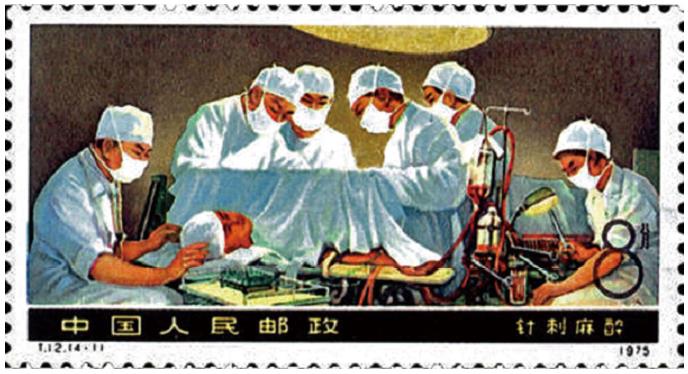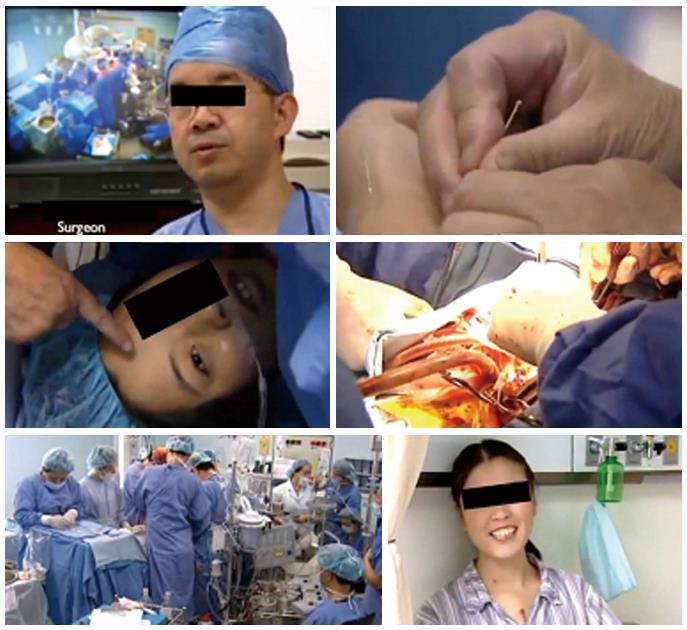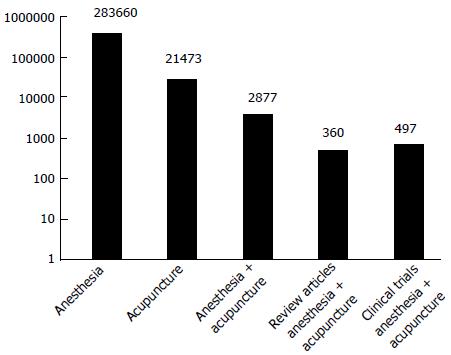Published online Mar 27, 2015. doi: 10.5313/wja.v4.i1.1
Peer-review started: November 9, 2014
First decision: December 17, 2014
Revised: December 22, 2014
Accepted: December 29, 2014
Article in press: December 29, 2014
Published online: March 27, 2015
Using acupuncture instead of anesthetics to induce analgesia was performed in China many years ago in surgical anesthetization. Although many medical units in China’s cities and rural areas are applying these techniques in operations, it should be pointed out that acupuncture anesthesia is still in the process of development and is of next to no practical and even less scientific value in the western world. However, acupuncture-assisted anesthesia can be useful also in countries other than China.
Core tip: Acupuncture anesthesia has been converted into acupuncture-assisted anesthesia in China. Acupuncture-assisted anesthesia reduces the demands of anesthetics and the post-operative complications and has a potential organ protective effect.
- Citation: Litscher G, Simonis H, Kröll W. Anesthesia and acupuncture. World J Anesthesiol 2015; 4(1): 1-4
- URL: https://www.wjgnet.com/2218-6182/full/v4/i1/1.htm
- DOI: https://dx.doi.org/10.5313/wja.v4.i1.1
Using acupuncture instead of anesthetics to induce analgesia was performed in China many years ago in surgical anesthetization. Although many medical units in China’s cities and rural areas are applying these techniques in operations, it should be pointed out that acupuncture anesthesia is still in the process of development and is of next to no practical and even less scientific value in the western world[1]. However, acupuncture-assisted anesthesia can be useful also in countries other than China.
The objective of this editorial is to present the experience with acupuncture-assisted anesthesia that can be found in the scientific literature. Showing traditional approaches to anesthesia may help to tackle problems that are still evident, such as postoperative nausea and pain. Evolution is usually a combination of conservatism and innovative thinking. The editorial should provide an open-minded account of experiences with acupuncture-assisted anesthesia, balanced with skepticism.
For many thousands of years, acupuncture has been proven effective in relieving pain[2]. Acupuncture anesthesia developed from acupuncture analgesia[2].
Two of the first reports concerning acupuncture-assisted anesthesia came from the Shanghai First People’s Hospital dated August 30 and September 5, 1958[2,3]. Doctors of Chinese and Western medicine worked together and learned from each other. Dr. Yin Huizhu carried out a tonsillectomy with acupuncture anesthesia without further use of anesthetics[2,3]. In the same year, electroacupuncture anesthesia was used for the first time at the 4th People’s Hospital of Xi’an[3]. A pneumonectomy under acupuncture anesthesia was performed in 1960 at the First Tuberculosis Hospital of Shanghai[2]. After this event, many satisfactory results were also obtained in other operations (cardiac surgery, total laryngectomy, cesarean section, surgery on the anterior cranial fossa, etc.)[2]. In 1971, Xinhua News reported about acupuncture anesthesia. The headline was “The Chinese medical personnel and scientists successfully invented acupuncture anesthesia”, and it was stated that more than 400000 surgical patients had undergone acupuncture anesthesia[3]. On July 26, 1971, even the New York Times published one of the first articles - “Now, let me tell you about my appendectomy in Peking …” - in the Western world on acupuncture anesthesia. Richard Nixon was the first United States President to visit China. At about that time, acupuncture started to become known to people outside Asia. As a consequence, in March 1972, Professor Johannes Bischko from Austria was the first surgeon in the West to perform a tonsillectomy with only acupuncture analgesia[4]. In 1975, as a sign of special recognition, a memorial stamp for the invention of acupuncture anesthesia was issued in China. The stamp shows a scene from the operating theater, and below it is written “acupuncture anesthesia”[5] (Figure 1).
By 1980, many surgeries had been performed under acupuncture anesthesia[2]. From 1986 to 2000, three Chinese national key projects were carried out, supported by the Chinese central government. Famous hospitals, e.g., from Beijing, Shanghai and Chengdu, participated in these studies. In these years, acupuncture mainly played a cooperating role in combination with drugs. Therefore, acupuncture combined with selected drugs was named “acupuncture-drug balanced anesthesia” or “acupuncture-balanced anesthesia”[2]. Because of several reforms in China and the import of modern anesthetic technology, acupuncture-induced anesthesia began to be deemed inadequate. Meanwhile, in China the term “acupuncture anesthesia” has been replaced by “acupuncture-assisted anesthesia” (similar to “acupuncture-balanced anesthesia”). The main goal of this “acupuncture-assisted anesthesia” is the reduction of the dosage of anesthetics, a reduction of the related complications and the protection of the involved organs like brain and heart.
In a documentary from 2006, which is part of a BBC series hosted by Kathy Sykes and has been released on the internet[6], a patient in China is having open heart surgery without general anesthesia, but with acupuncture “instead” (Figure 2). However, the report is massively biased to exaggerate the role of acupuncture. It is casually mentioned that the patient had undergone sedation and local anesthesia (her chest was numbed), as if this was a tiny detail[7]. There is no mention of whether or not you could have the same procedure with conscious sedation and local anesthesia, but without the acupuncture[6,7].
The scene in the BBC documentary[6,8] which shows the 21-year-old patient undergoing heart surgery punctured with needles left viewers under the strong impression that acupuncture was providing immense pain relief. However, Singh reported in “The Telegraph”[9] that “in addition to acupuncture, the patient had a combination of three very powerful sedatives (midazolam, droperidol, fentanyl) and large volumes of local anaesthetic injected into the chest”[9].
Although acupuncture-assisted anesthesia for open heart surgery has declined in recent years, there is a renewed interest in it due to the escalating medical costs. Zhou et al[10], for example, came to the conclusion that a combined acupuncture-medicine anesthesia strategy can reduce the postoperative morbidity and medical costs in patients undergoing open heart surgery under cardiopulmonary bypass[10].
It is the authors’ opinion that acupuncture-anesthesia alone will never be used in the western world, since modern technology offers better and safer possibilities. However, acupuncture does represent a very good method to alleviate the side-effects of anesthesia such as post-operative nausea and vomiting, pain and dizziness, which has been shown in several studies[1,11-13].
A literature research in the scientific database PubMed (Oct 31, 2014) shows many studies concerning the topic “anesthesia and acupuncture”; there are also almost 500 clinical trials on this topic (Figure 3). Several review articles, e.g., the paper by Lee et al[14] in Pain, concluded that “This review does not support the use of acupuncture as an adjunct to standard anesthetic procedures during surgery”[14].
Acupuncture anesthesia has been converted into acupuncture-assisted anesthesia in China. Acupuncture-assisted anesthesia reduces the demands of anesthetics and the post-operative complications and has a potential organ protective effect. Therefore, acupuncture may be an excellent adjunct to reduce peri- and postoperative pain. This conclusion, however, has to be explored in detail in further scientific studies.
P- Reviewer: Afzal M, Li JF, Sandblom G S- Editor: Tian YL L- Editor: A E- Editor: Wu HL
| 1. | Ho ST, Lu LK. The principles and practical use of acupuncture anaesthesia. Hong Kong: Medicine & Health Publishing 2000; . [Cited in This Article: ] |
| 2. | Wu GC. Acupuncture anesthesia in China: retrospect and prospect. Chin J Integr Med. 2007;13:163-165. [PubMed] [Cited in This Article: ] |
| 3. | Zhang LJ, editor . Historical narratives of acu-moxibustion. Beijing: People’s Medical Publishing House 2010; 90. [Cited in This Article: ] |
| 4. | Richard M. Johannes Bischko - ein Leben für die Akupunktur. Wien München Bern: Wilhelm Maudrich 2005; . [Cited in This Article: ] |
| 5. | Cheng TO. Stamps in cardiology. Acupuncture anaesthesia for open heart surgery. Heart. 2000;83:256. [PubMed] [DOI] [Cited in This Article: ] [Cited by in Crossref: 14] [Cited by in F6Publishing: 14] [Article Influence: 0.6] [Reference Citation Analysis (1)] |
| 6. | Giles B, Finch A, editors . The Science of Acupuncture. United Kingdom: BBC 2006; . [Cited in This Article: ] |
| 7. | Novella S. BBC fail on acupuncture documentary. Neurologica-blog [Internet] (New England Skeptical Society;. United Kingdom: BBC 2014; July 15) Available from: http://theness.com/neurologicablog/index.php/bbc-fail-on-acupuncture-documentary/. [Cited in This Article: ] |
| 8. | Wu GC, Wang YQ, Cao XD. Acupuncture-drug balanced anesthesia. Acupuncture Therapy for Neurological Diseases. Berlin Heidelberg: Springer 2010; 143-161. [Cited in This Article: ] |
| 9. | Singh S. Did we really witness the ‘amazing power’ of acupuncture? (The Telegraph;. Berlin Heidelberg: Springer 2006; February 14)? Available from: http://www.telegraph.co.uk/science/science-news/3344833/Did-we-really-witness-the-amazing-power-of-acupuncture.html. [Cited in This Article: ] |
| 10. | Zhou J, Chi H, Cheng TO, Chen TY, Wu YY, Zhou WX, Shen WD, Yuan L. Acupuncture anesthesia for open heart surgery in contemporary China. Int J Cardiol. 2011;150:12-16. [PubMed] [DOI] [Cited in This Article: ] [Cited by in Crossref: 31] [Cited by in F6Publishing: 33] [Article Influence: 2.5] [Reference Citation Analysis (1)] |
| 11. | Yan Q, Feng Y. Acupuncture assisted anesthesia and its organ protective effects. Zhongguo Zhenjiu. 2013;33:765-768. [PubMed] [Cited in This Article: ] |
| 12. | Wang H, Xie Y, Zhang Q, Xu N, Zhong H, Dong H, Liu L, Jiang T, Wang Q, Xiong L. Transcutaneous electric acupoint stimulation reduces intra-operative remifentanil consumption and alleviates postoperative side-effects in patients undergoing sinusotomy: a prospective, randomized, placebo-controlled trial. Br J Anaesth. 2014;112:1075-1082. [PubMed] [DOI] [Cited in This Article: ] [Cited by in Crossref: 60] [Cited by in F6Publishing: 78] [Article Influence: 7.8] [Reference Citation Analysis (0)] |
| 13. | Yang L, Yang J, Wang Q, Chen M, Lu Z, Chen S, Xiong L. Cardioprotective effects of electroacupuncture pretreatment on patients undergoing heart valve replacement surgery: a randomized controlled trial. Ann Thorac Surg. 2010;89:781-786. [PubMed] [DOI] [Cited in This Article: ] [Cited by in Crossref: 55] [Cited by in F6Publishing: 57] [Article Influence: 4.1] [Reference Citation Analysis (0)] |











